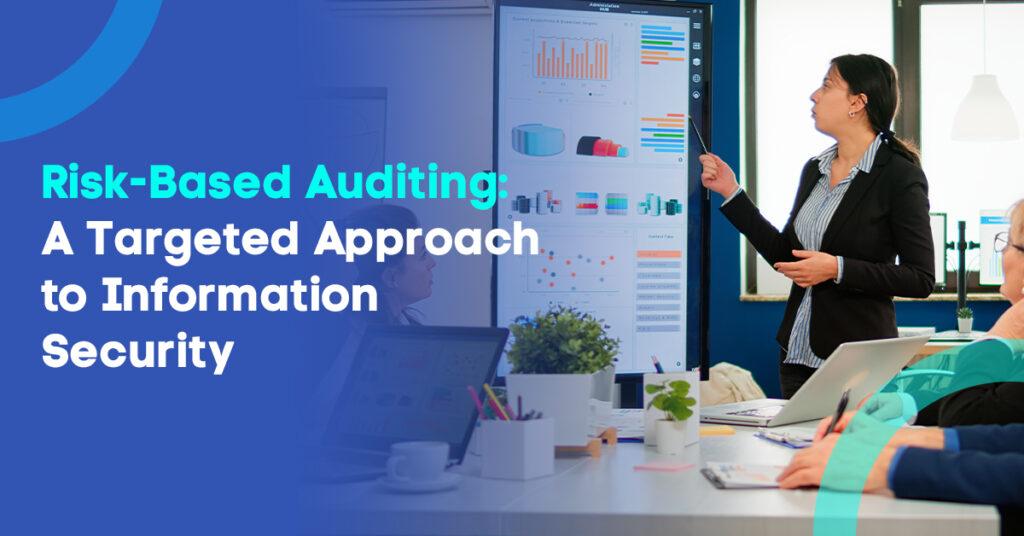Risk-Based Auditing: A Targeted Approach to Information Security
Posted on : 28 September 2024 at 14:40 pm, by Puneet Aggarwal, Founder 7 dot 2 IT Consulting

Renowned playwright and screenwriter Aaron Sorkin once remarked, “The first step to solving a problem is recognizing there is one”. This line stands valid even in today’s digital age, where information security is a critical aspect of business operations. Companies across industries face a growing number of cyber threats, data breaches, and regulatory challenges. And, to effectively combat these risks, a proactive and structured approach is extremely important. Risk-based auditing has emerged as a powerful method for identifying and addressing the most significant risks within an organization’s information security framework.
What is Risk-Based Auditing?
Risk-based auditing is an auditing approach that focuses on identifying, assessing, and addressing the highest-priority risks an organization faces. Rather than conducting a blanket audit of all processes, this method targets areas that pose the greatest threats to the organization’s objectives. By doing so, it ensures that resources are allocated efficiently, and the most critical risks are addressed first. In the context of information security, risk-based auditing involves reviewing security controls, processes, and policies that directly affect data protection, confidentiality, integrity, and availability.
Why Information Security Matters?
Information security is no longer just a compliance requirement which organisations should meet but it’s a strategic necessity. As businesses adopt digital solutions and handle sensitive data, they become prime targets for cyberattacks. Information security is important for the following reasons –
- Increased Cyberattacks: Organizations face increasing threats from phishing attacks, ransomware, and insider threats. The consequences of a security breach can be devastating, from financial loss to reputational damage.
- Regulatory Compliance: With regulations like GDPR, HIPAA, and CCPA in place, businesses are legally required to protect customer data. Non-compliance can result in hefty fines, legal consequences, and loss of trust.
- Reputation and Trust: In an era where data breaches make headlines, clients and customers expect businesses to protect their data. A failure to do so can erode consumer trust and tarnish an organization’s brand.
The Importance of Risk-Based Auditing in Information Security
- Targeted Resource Allocation: Risk-based auditing helps companies allocate resources where they are most needed. Instead of applying a one-size-fits-all audit, organizations can focus on the most vulnerable areas of their information security, ensuring that critical threats are mitigated quickly.
- Improved Decision-Making: By identifying key risks, organizations can prioritize their information security efforts, aligning them with overall business goals. This strategic focus allows companies to take preventive measures before a threat materializes.
- Compliance and Regulatory Assurance: Risk-based auditing ensures that organizations remain compliant with evolving regulatory frameworks. By assessing high-risk areas, companies can ensure that they meet legal requirements and avoid penalties.
- Enhanced Security Posture: By focusing on the most critical risks, businesses can improve their overall security posture. This method allows for the identification of gaps in current controls and policies, enabling the implementation of stronger security measures.
Key Components of a Risk-Based Audit for Information Security
- Risk Assessment: The first step in a risk-based audit is a thorough risk assessment. This involves identifying and evaluating potential risks based on their likelihood and potential impact. Risk assessments should be aligned with the organization’s business objectives and operational needs.
- Control Evaluation: Once risks are identified, the next step is to evaluate the effectiveness of existing controls. This includes assessing the organization’s IT infrastructure, security policies, encryption methods, and incident response protocols. The goal is to determine whether these controls are adequate in mitigating identified risks.
- Continuous Monitoring: Risk-based auditing is not a one-time process. It requires continuous monitoring to ensure that risks are managed effectively over time. Auditors should regularly review risk levels, control performance, and emerging threats to maintain a proactive stance on information security.
- Reporting and Recommendations: Once the audit is complete, auditors provide a detailed report of their findings. This includes identified risks, control weaknesses, and actionable recommendations for improvement. The report helps management make informed decisions about resource allocation, policy updates, and future security investments.
Challenges in Implementing Risk-Based Auditing
While risk-based auditing offers many benefits, it also presents certain challenges.
- Complex Risk Identification: Accurately identifying risks in a complex IT environment can be difficult. Cyber threats evolve rapidly, and new vulnerabilities can emerge unexpectedly, making risk identification an ongoing challenge.
- Balancing Cost and Security: Businesses often face pressure to balance security measures with operational costs. While a risk-based audit prioritizes key areas, some organizations may struggle to allocate sufficient resources to address all identified risks.
- Changing Regulatory Requirements: As regulations evolve, businesses must stay up to date with new requirements. Ensuring that audits remain compliant with current laws and standards requires regular updates to risk assessment methodologies.
Conclusion: A Proactive Approach to Information Security!
Risk-based auditing is a powerful tool for modern organizations looking to strengthen their information security posture. By focusing on the highest-priority risks, businesses can improve resource allocation, enhance compliance, and mitigate the impact of cyber threats. To implement a successful risk-based audit, organizations should continuously update risk assessments to reflect emerging threats and changes in the regulatory landscape. In an era of increasing cyberattacks and stringent regulations, this targeted approach offers a proactive solution to protect valuable data and maintain trust. Through regular risk-based audits, organizations can stay ahead of evolving threats, secure their systems, and ensure they remain resilient in an increasingly complex digital world.
